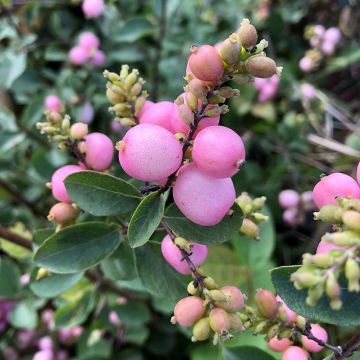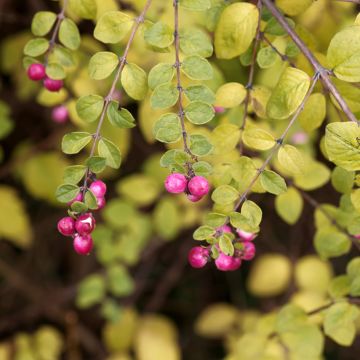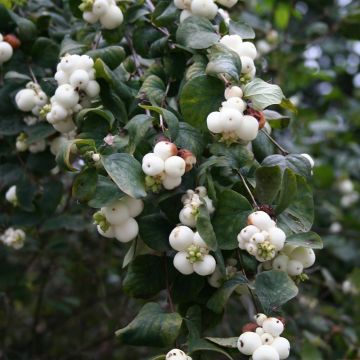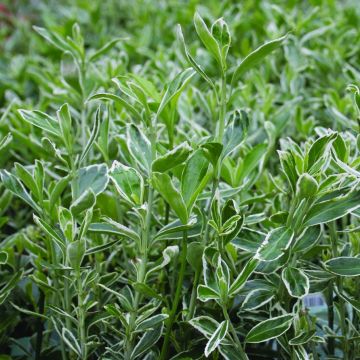

Symphorycarpos x doorenboosii Magical Berry Christmas - Doorenbos coralberry


Symphorycarpos x doorenboosii Magical Berry Christmas - Doorenbos coralberry
Symphorycarpos x doorenboosii Magical Berry Christmas - Doorenbos coralberry
Symphorycarpos x doorenboosii 'Kolmaberc' Magical Berry Christmas®
Doorenbos Coralberry, Snowberry 'Doorenbos', 'Kolmaberc'
This item cannot be shipped to the selected country
Delivery charge from €5.90
More information
Schedule delivery date,
and select date in basket
This plant carries a 24 months recovery warranty
More information
We guarantee the quality of our plants for a full growing cycle, and will replace at our expense any plant that fails to recover under normal climatic and planting conditions.
From €5.90 for pickup delivery and €6.90 for home delivery
Express home delivery from €8.90.
Does this plant fit my garden?
Set up your Plantfit profile →
Description
Like the other symphorines in the 'Magical' series, the Symphoricarpos Magical Berry Christmas is covered with large clusters of round berries. Still, its berries are almost red, and they persist until December. This compact bush is perfect for adding a touch of magic and colour to the garden during the "off-season", mainly because it feeds certain birds. Plant it in a small free hedge, in a large mass of plants, even in the shade of large trees. This symphorine can also be displayed in a large pot on the balcony or patio.
The Symphoricarpos x doorenbosii is a plant from the Caprifoliaceae family resulting from the crossbreeding between the Symphoricarpos albus var. laevigatus, native to the Eastern Rocky Mountains in the USA and the S. chenaultii, a horticultural hybrid. All these plants are perfectly cold-resistant and remarkably adaptable: they are easy to live within all regions and tolerate a wide range of soils and exposures.
The Symphoricarpos 'Magical Berry Christmas' 'Kolmaberc' is part of a series of recent hybrids selected in the Netherlands for their generous fruiting. It is a deciduous bush with a slightly suckering stump that is fast-growing. Reaching about 1.25 m in height and 1 m in width at maturity, it spreads laterally without theoretical limits. Its habit is generally rounded, dense and compact, supported by upright, well-branched stems that arch over time. The foliage, deciduous, appears in spring and falls in autumn. It consists of small oval leaves measuring 2 to 4 cm long. Dark green on the top, they are lighter on the underside and turn yellow before falling. The flowering, inconspicuous to human eyes, attracts pollinating insects. It takes place in May-June, in the axils of the leaves, in clusters of tiny bells. After pollination, they give way to round and spongy fruits measuring 1.5 to 2 cm in diameter, becoming almost red when ripe—these berries, which are the beauty of the bush, often last until December. Inedible for humans, they are appreciated by birds and game.
This 'Magical Berry Christmas' symphorine is a resistant and highly hardy bush, capable of adapting to many growing conditions and all regions, including the average mountain or the hardships of the Mediterranean summer when planted in the shade. This bush easily integrates into a small free hedge or a large, unpretentious shrub mass in a garden that leaves room for nature. Many other deciduous or evergreen shrubs, with flowers or berries, will accompany it: spireas, shrubby honeysuckles, botanical roses, coloured Berberis... The branches loaded with fruits of the symphorines can also be used to make beautiful autumn bouquets.
Report an error about the product description
Plant habit
Flowering
Foliage
Botanical data
Symphorycarpos
x doorenboosii
'Kolmaberc' Magical Berry Christmas®
Caprifoliaceae
Doorenbos Coralberry, Snowberry 'Doorenbos', 'Kolmaberc'
Cultivar or hybrid
Other Symphoricarpos
Planting and care
The 'Magical Berry Christmas' Symphorine adapts to all exposures and climates: it tolerates shade but will be more floriferous and fruit-bearing in partial or non-burning sun. It is a hardy and easy-to-grow bush suitable for any good garden soil, limestone, neutral or slightly acidic. It tolerates wet or dry soils in summer and is found under large trees and at the base of hedges. You can prune in late winter to maintain balance.
Planting period
Intended location
Care
This item has not been reviewed yet - be the first to leave a review about it.
Hedge shrubs
Haven't found what you were looking for?
Hardiness is the lowest winter temperature a plant can endure without suffering serious damage or even dying. However, hardiness is affected by location (a sheltered area, such as a patio), protection (winter cover) and soil type (hardiness is improved by well-drained soil).

Photo Sharing Terms & Conditions
In order to encourage gardeners to interact and share their experiences, Promesse de fleurs offers various media enabling content to be uploaded onto its Site - in particular via the ‘Photo sharing’ module.
The User agrees to refrain from:
- Posting any content that is illegal, prejudicial, insulting, racist, inciteful to hatred, revisionist, contrary to public decency, that infringes on privacy or on the privacy rights of third parties, in particular the publicity rights of persons and goods, intellectual property rights, or the right to privacy.
- Submitting content on behalf of a third party;
- Impersonate the identity of a third party and/or publish any personal information about a third party;
In general, the User undertakes to refrain from any unethical behaviour.
All Content (in particular text, comments, files, images, photos, videos, creative works, etc.), which may be subject to property or intellectual property rights, image or other private rights, shall remain the property of the User, subject to the limited rights granted by the terms of the licence granted by Promesse de fleurs as stated below. Users are at liberty to publish or not to publish such Content on the Site, notably via the ‘Photo Sharing’ facility, and accept that this Content shall be made public and freely accessible, notably on the Internet.
Users further acknowledge, undertake to have ,and guarantee that they hold all necessary rights and permissions to publish such material on the Site, in particular with regard to the legislation in force pertaining to any privacy, property, intellectual property, image, or contractual rights, or rights of any other nature. By publishing such Content on the Site, Users acknowledge accepting full liability as publishers of the Content within the meaning of the law, and grant Promesse de fleurs, free of charge, an inclusive, worldwide licence for the said Content for the entire duration of its publication, including all reproduction, representation, up/downloading, displaying, performing, transmission, and storage rights.
Users also grant permission for their name to be linked to the Content and accept that this link may not always be made available.
By engaging in posting material, Users consent to their Content becoming automatically accessible on the Internet, in particular on other sites and/or blogs and/or web pages of the Promesse de fleurs site, including in particular social pages and the Promesse de fleurs catalogue.
Users may secure the removal of entrusted content free of charge by issuing a simple request via our contact form.
The flowering period indicated on our website applies to countries and regions located in USDA zone 8 (France, the United Kingdom, Ireland, the Netherlands, etc.)
It will vary according to where you live:
- In zones 9 to 10 (Italy, Spain, Greece, etc.), flowering will occur about 2 to 4 weeks earlier.
- In zones 6 to 7 (Germany, Poland, Slovenia, and lower mountainous regions), flowering will be delayed by 2 to 3 weeks.
- In zone 5 (Central Europe, Scandinavia), blooming will be delayed by 3 to 5 weeks.
In temperate climates, pruning of spring-flowering shrubs (forsythia, spireas, etc.) should be done just after flowering.
Pruning of summer-flowering shrubs (Indian Lilac, Perovskia, etc.) can be done in winter or spring.
In cold regions as well as with frost-sensitive plants, avoid pruning too early when severe frosts may still occur.
The planting period indicated on our website applies to countries and regions located in USDA zone 8 (France, United Kingdom, Ireland, Netherlands).
It will vary according to where you live:
- In Mediterranean zones (Marseille, Madrid, Milan, etc.), autumn and winter are the best planting periods.
- In continental zones (Strasbourg, Munich, Vienna, etc.), delay planting by 2 to 3 weeks in spring and bring it forward by 2 to 4 weeks in autumn.
- In mountainous regions (the Alps, Pyrenees, Carpathians, etc.), it is best to plant in late spring (May-June) or late summer (August-September).
The harvesting period indicated on our website applies to countries and regions in USDA zone 8 (France, England, Ireland, the Netherlands).
In colder areas (Scandinavia, Poland, Austria...) fruit and vegetable harvests are likely to be delayed by 3-4 weeks.
In warmer areas (Italy, Spain, Greece, etc.), harvesting will probably take place earlier, depending on weather conditions.
The sowing periods indicated on our website apply to countries and regions within USDA Zone 8 (France, UK, Ireland, Netherlands).
In colder areas (Scandinavia, Poland, Austria...), delay any outdoor sowing by 3-4 weeks, or sow under glass.
In warmer climes (Italy, Spain, Greece, etc.), bring outdoor sowing forward by a few weeks.























































